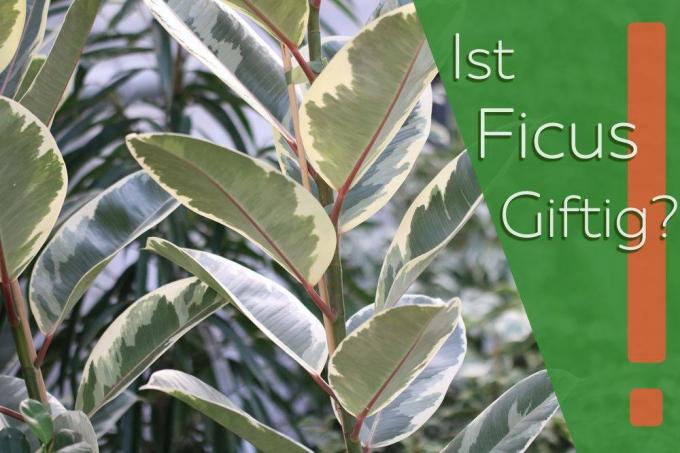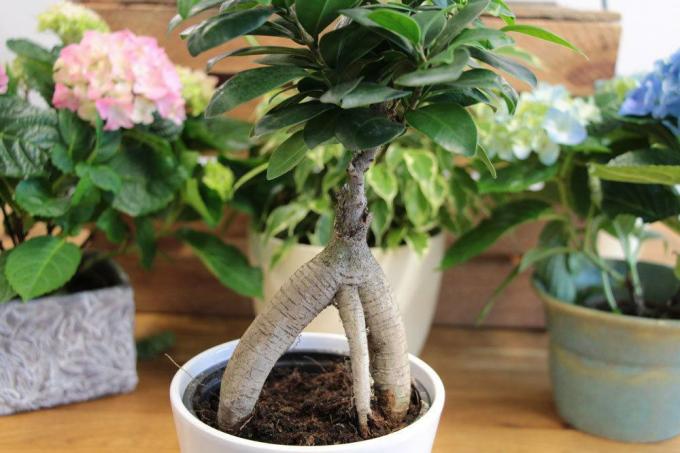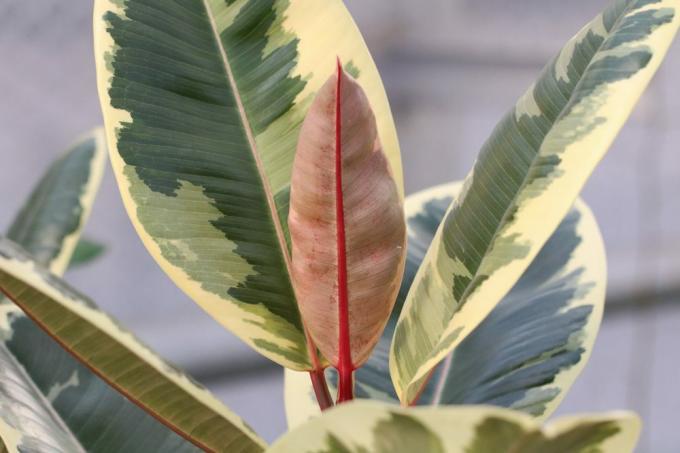
table of contents
- Is Ficus Poisonous?
- Toxic ingredients
- Symptoms of intoxication
- Green-leaved ficus species
- Species with monochrome and multicolored foliage
The genus Ficus comprises more than 800 species, from ground cover to climbing and hanging specimens to trees. Some of them are classics among indoor plants thanks to their appearance and unpretentiousness. Probably the most famous representative is Ficus Benjamini. But the others also have a high ornamental value, be it due to the growth habit or the shape and color of the leaves. But what about the toxicity?
Is Ficus Poisonous?
All Ficus species are mildly poisonous to humans in all parts of the plant, including the unripe fruit. Caution is particularly advisable if small children, but also dogs, cats, birds or rodents live in the household, because depending on the dose, they can also lead to more severe poisoning.
Toxic ingredients
Its ingredients provide information about whether and how toxic ficus is. The white milky sap contained in the plants plays a special role in this. The poisonous substances are in it. Above all, rubber, flavonoids and so-called coumarins should be mentioned.
- Rubber, a natural component of many plants
- The proteins in natural rubber are dangerous
- Can lead to allergic reactions, especially in sensitive people
- Or trigger a rubber allergy
- Flavonoids are secondary plant substances
- Are responsible for the unpleasant bitter taste
- Numerous plants serve as effective protection against predators
- Furocoumarins have the highest poisonous potential in ficus
- Are formed as secondary plant substances
- Can protect against diseases caused by fungi or bacteria
- Together with flavonoids and natural rubber, negative for human and animal health

tip: Even if the ficus is only slightly poisonous, it is advisable to wear gloves when handling these plants to avoid irritating the skin.
Symptoms of intoxication
people
- If individual parts of the plant are swallowed, symptoms of poisoning are possible
- The dose makes the poison
- Babies and toddlers are particularly at risk
- Putting in the mouth or licking leaves is already dangerous for children
- May cause nausea, vomiting, stomach cramps, diarrhea and dizziness
- See a pediatrician if you have the slightest suspicion
- However, ingestion of larger amounts is also problematic for adults
- The consequence can then be gastrointestinal complaints with vomiting and diarrhea
Due to the bitter taste, hardly any toxic dose is usually reached in adults. However, if symptoms of poisoning occur, it is advisable to give plenty of fluids in the form of water or tea. In the event of contact with skin and eyes, wash both off well with water. rinse.
tip: What one should definitely not do in the event of poisoning is to induce vomiting in the affected person.
Effect on pets such as cats, dogs and birds
The leaves of plants in particular exert a magical attraction on pets such as dogs and cats, but also on birds and rodents. In contrast to humans, even small amounts of ficus are highly toxic to them. They can lead to severe poisoning and even respiratory paralysis.
While kidney failure is often the result in cats, three to four leaves can cause paralysis and even death in small rodents. In birds, the skin can be reddened and burned, as well as irritation of the gastrointestinal tract. To prevent all of this, you should choose a location for these plants out of the reach of the animals.
Green-leaved ficus species
Violin fig (Ficus lyrata)
- Extremely decorative and several meters high houseplant
- Owes its name to the large, wavy leaves
- Are dark green, up to 45 cm long and 12-28 cm wide
- Grows as an evergreen tree or shrub
- Avoid drafts, temperature fluctuations and cold feet at all costs
- Otherwise there is a risk of leaf loss
- Suitable for both soil and hydroponics

Congo fig (Ficus buxifolia)
This fig tree grows fast, slender, shrub-like and forms thin, curved shoots in the process. It can reach heights of 200 cm after a short time. The green, boxwood-like and almost triangular leaves sit on the shoots. Flowers are usually not formed when kept indoors.
Bay fig / Chinese fig (Ficus' Ginseng '/' F. microcarpa ‘)
Ficus 'Ginseng' is a real gem among indoor plants. It impresses with a rounded, richly branched crown of leaves and a strong trunk. This bizarrely shaped, intertwined stump is reminiscent of a ginseng root. The glossy dark green, up to eight centimeters long leaves are rough, leathery, with entire margins and oval. Under optimal conditions they produce fruits that are inedible, however.

Mistletoe fig (Ficus deltoidea)
The mistletoe fig grows like a bush and comparatively slowly. In indoor cultivation it reaches heights of about 150 cm. Not only is it very decorative, it can also reduce pollutants such as formaldehyde, benzene and trichlorethylene and thus improve the air in the room. Their leaves are leathery and green. It forms small yellow figs in their natural habitat.

tip: As a houseplant it can develop inconspicuous white flowers, but the fruits usually fall off prematurely.
Poplar fig (Ficus religiosa)
- also known as buddha tree, indian pepul tree or bob tree
- Counts too fast and bushy growing fig trees
- Dark green leaves up to 12 cm long and lightly veined
- Significantly softer than those of other species
- A special feature of the leaves are the so-called trickle tips
- What is meant are the elongated leaf tips
- The length of the tips is about half that of the leaf blades

Narrow-leaved weeping fig (Ficus binnendijkii)
Among the numerous types of ficus, this weeping fig stands out thanks to its appearance. Their up to 20 cm long, narrow leaves are responsible for this. They make this uncomplicated plant appear particularly bushy. With its slim, upright growth, it exudes a certain elegance. It can reach heights of up to 300 cm.
Species with monochrome and multicolored foliage
Australian fig / rust fig (Ficus rubiginosa / australis)
- Medium-sized shrub or small tree
- Heights of about 150 cm
- Leaves are oblong ovate and leathery, shiny
- Leaf tops dark green, undersides rust-colored and hairy
- Likes to be outdoors in summer
- In addition to pure green, there is also a colorful variety ('Variegata')
- Leaves of this variety variegated cream-white
- Flower formation possible
- At best also pear to circular, yellow-green fruits

tip: The variety with the multicolored leaves require more light than the variety with pure green foliage.
Weeping fig (Ficus benjamina)
The weeping fig is probably the best-known and most popular species of ficus in this country. It grows as an evergreen shrub or tree and can reach stately heights. It impresses with a dense dress of slightly wavy, light or dark green as well as yellow-green or white marbled leaves and overhanging branches. The varieties Ficus benjamina 'Starlight' and 'Golden King' are particularly recommended.

Note: This type of ficus is considered to be the trigger for a latex allergy.
Rubber tree (Ficus elastica)
Even the well-known one Rubber tree In contrast to most of the others, it forms a straight growing main shoot without side shoots. Branching can also be achieved without any problems by pruning the ficus elastica. Its large, rubbery and shiny leaves are characteristic. Depending on the variety, they can be completely dark green, but also cream-pink-red or cream-gray variegated as well as spotted yellow and bordered in yellow.

tip: Varieties with multi-colored leaves such as 'Decora tricolor' and 'Schriveriana' are particularly decorative.
Climbing fig (Ficus pumila / repens)
This climbing ficus is comparatively small, has strong branches and climbs. The leaves are thin, slightly heart-shaped and, depending on the variety, dark green or green with a white border or white or cream colored polka dots. They are slightly wavy and about 2 cm long. The climbing fig is ideal as a traffic light plant, but can also climb up a moss stick. It can also be outdoors from spring to autumn. It is also possible to keep it in a bucket, for example on a wall or house wall on which it climbs. But it should spend the winter in the house.




